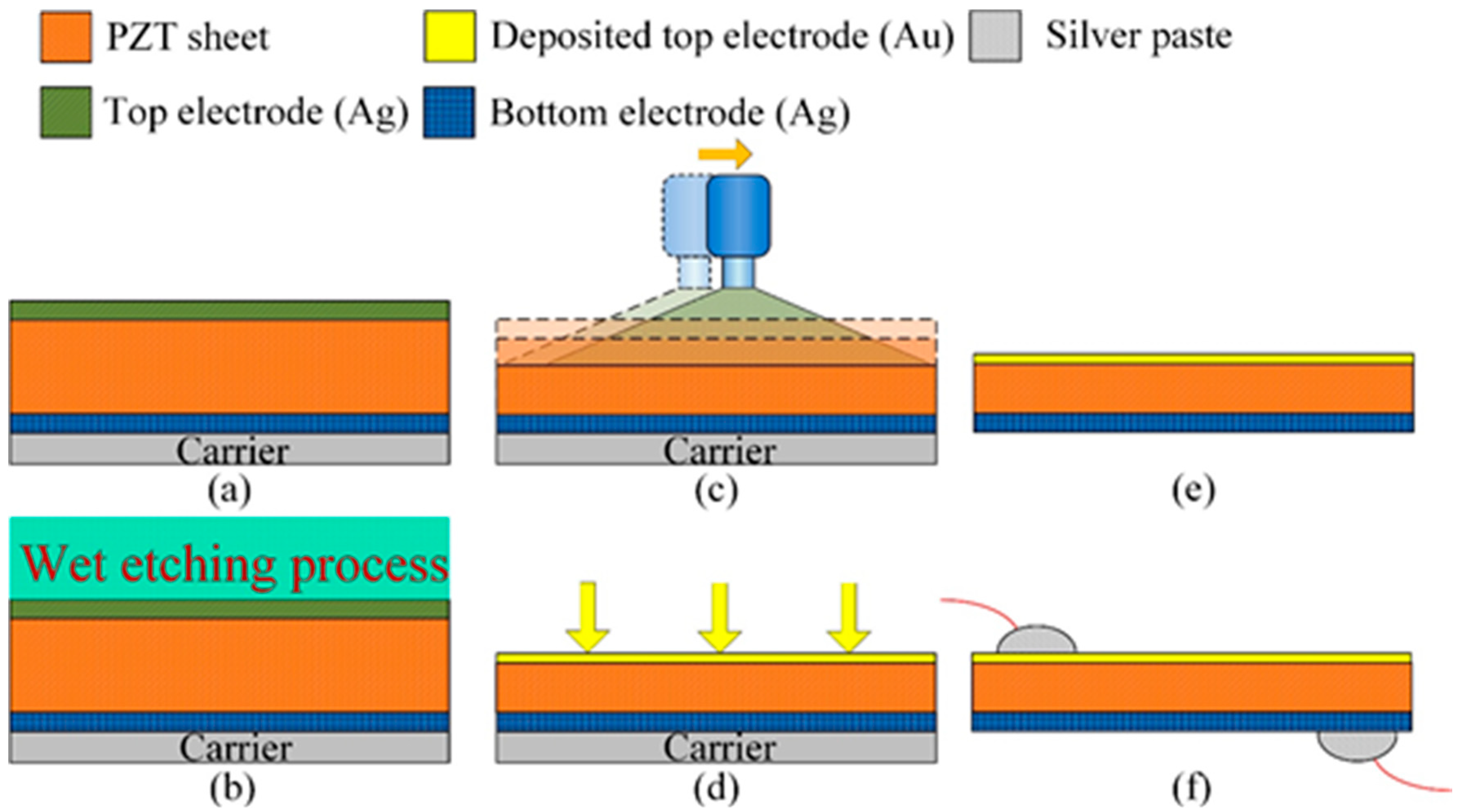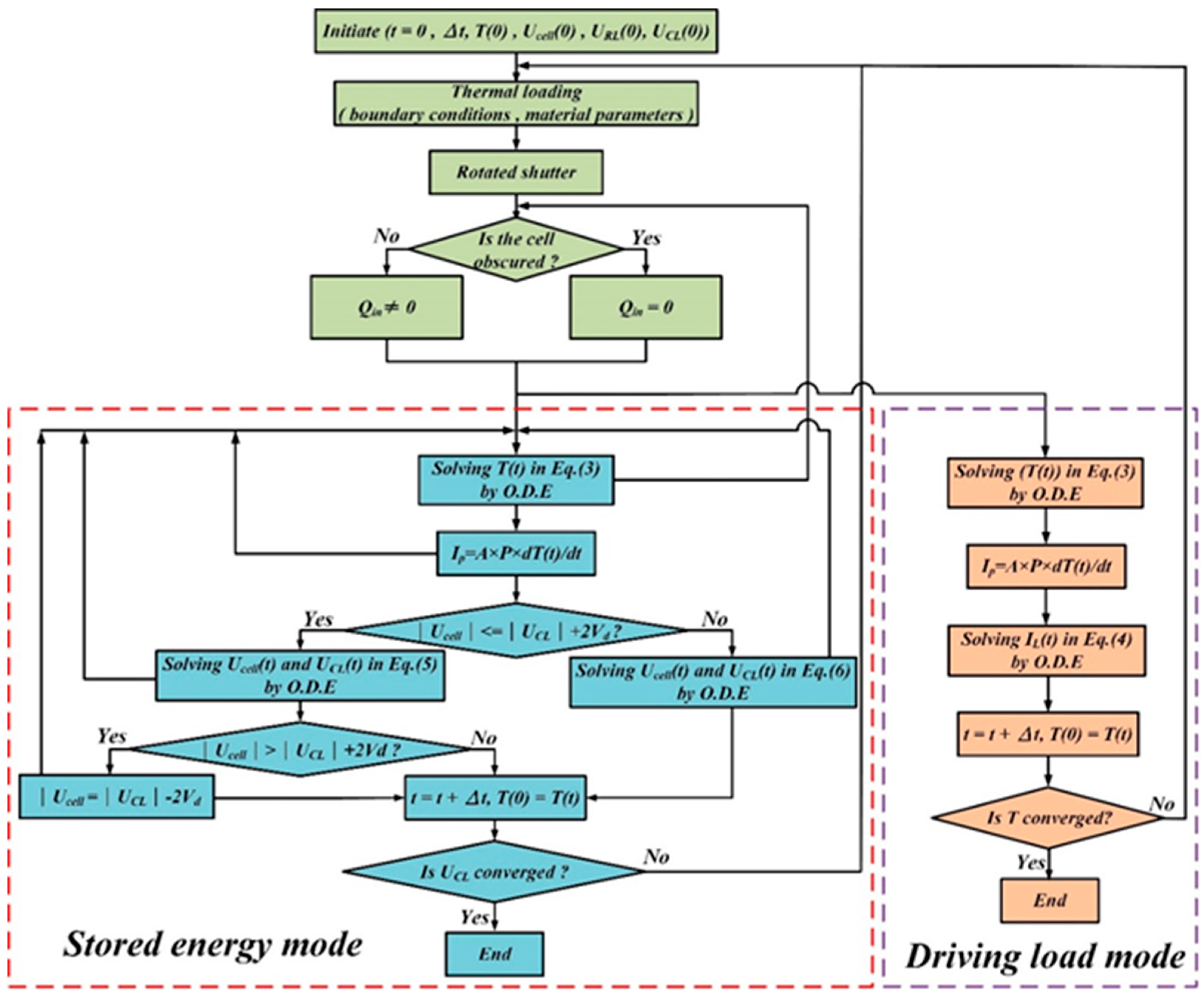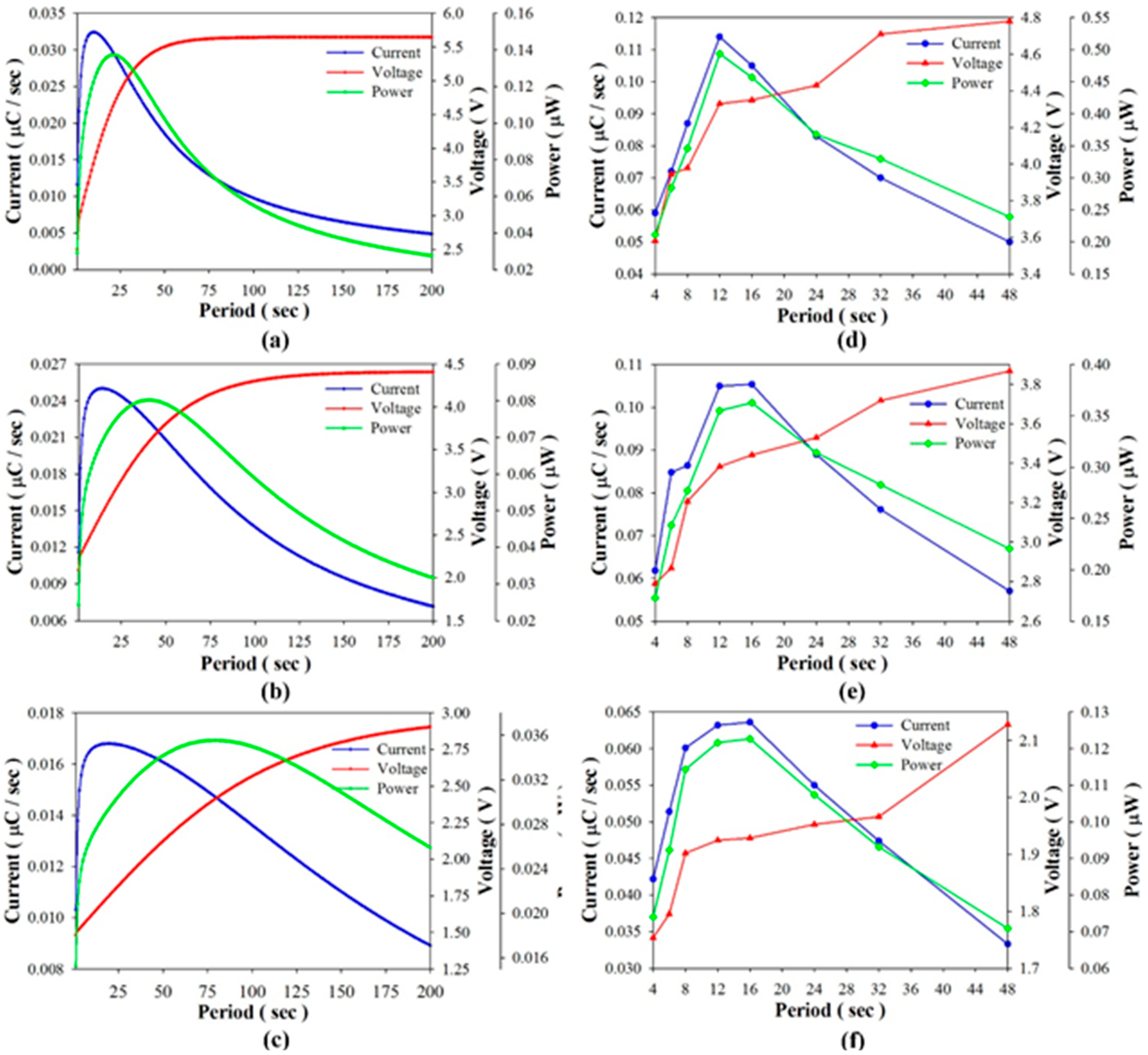2.1. Fabrication of Pyroelectric Cells
A PZT pyroelectric cell with the dimensions of 9 mm × 9 mm × 0.414 mm was used. The cell comprised a 0.4 mm-thick PZT sheet sandwiched between a top and a bottom electrode. The electrodes were of 7 μm-thick silver film. The PZT cells were provided by Eleceram Technology Co.
Table 1 shows the properties of the commercial PZT pyroelectric cell. Hsiao
et al. [
4] used a sandblast etching technique to trench complex patterns in commercial PZT sheets to improve the temperature variation rate and enhance the efficiency of pyroelectric harvesters. Thus, sandblast etching has been proven to be a beneficial technique for fabricating various geometries and thicknesses of pyroelectric cells. The schematic diagram of the sandblast etching apparatus is depicted in
Figure 1. This machine, molded into a dry blasting machine, was manufactured and assembled by the Shang-Po Sander Co. Ltd. (New Taipei city, Taiwan). A dry sandblasting machine generally consists of six systems: (i) the structural system; (ii) the media power system; (iii) the piping system; (iv) the dust removal system; (v) the control system; and (vi) the auxiliary system. The working principle of sandblast etching is that compressed air carrying aluminum oxide sand at high speed collides with the surface of the workpiece; compressed air flows through a valve to form negative pressure and the aluminum oxide sand is drawn into the blasting gun. Aluminum oxide sand is accelerated and spurted from the ceramic nozzle to etch the substrates.
Table 1.
Properties of the commercial PZT pyroelectric sheet.
Table 1.
Properties of the commercial PZT pyroelectric sheet.
| Sample ID | Thickness (μm) | Area (mm2) | Size (mm × mm) | Relative Dielectric Constant (ε33T/εO) | Density (g/cm3) | Poling Field (V/μm) | Pyroelectric Coefficient (10−4·C·m−2·K−1) |
|---|
| KA | 400 | 81 | 9 × 9 | 2100 | 7.9 | 3.5 | 6.97 |
Figure 1.
Schematic diagram of the sandblast etching machine.
Figure 1.
Schematic diagram of the sandblast etching machine.
The process flow of the PZT pyroelectric cells is shown in
Figure 2. First, the PZT sheet was attached to a carrier of glass substrate, as shown in
Figure 2a. Wet etchant of HNO
3:H
2O = 7:3 was used to remove the top electrode, as shown in
Figure 2b. The sandblast etching machine was used to manufacture PZT cells with various thicknesses, as shown in
Figure 2c. Then, a 100 nm-thick gold film was deposited on the top side of the PZT sheets to produce the top electrode using an E-beam evaporator, as shown in
Figure 2d. Finally, the carrier was removed to achieve the fabrication of the PZT pyroelectric cells, as shown in
Figure 2e. The top and the bottom electrodes were connected with copper wires by a silver paste for measuring the electrical properties, as shown in
Figure 2f. The fabricated pyroelectric cells with various thicknesses are shown in
Figure 3.
Figure 2.
Fabrication flow of the PZT pyroelectric cell.
Figure 2.
Fabrication flow of the PZT pyroelectric cell.
Figure 3.
Fabricated pyroelectric cells with various thicknesses.
Figure 3.
Fabricated pyroelectric cells with various thicknesses.
2.2. Thermodynamic and Electric Models
Pyroelectricity is an electrical current generation from time-dependent temperature fluctuations. The pyroelectric cell is used to convert temperature fluctuations into the induced charge, which is usually considered to be a current source in parallel with its equivalent capacitance,
CP, and resistance,
RP. The thermodynamic governing equations were constructed according to a lumped parameter thermodynamic model, which was adopted to estimate the transient thermal response of the pyroelectric cell, as follows [
9]:
where
Qin is the input radiation power;
Qloss is the heat loss from the cell to the environment;
Qcell is the power generation of the cell; α is the heat absorption rate of the pyroelectric material;
T(t) is the transient temperature in the cell;
Tair is the ambient temperature;
CT is the thermal capacitance of the cell;
Ccell is the specific heat of the cell; A is the electrode area of the cell;
h is the natural convection coefficient of the cell;
Rconv is the thermal resistance caused by convection;
Ip is the pyroelectric current;
Ucell is the generated voltage in the cell; σ is the Stefan-Boltzmann constant (5.67 × 10
−8 W·m
−2·K
−4); ε is the emissivity on the irradiated surface of the cell; ρ is the density of the cell;
L and
d are the width and thickness, respectively, of the cell with a square sheet. Furthermore, the current
Ip can be determined using Equation (1). The circuit analysis was divided into two parts: first, driving a load resistance (
RL); and second, using a bridge rectifier to store the electrical energy in a stored capacitor (
CL), as depicted in
Figure 4.
Figure 4.
Model of electric energy harvesting process using pyroelectric cells: (a) directly driving a load resistance (RL); (b) using a bridge rectifier to store the electrical energy in a storage capacitor (CL).
Figure 4.
Model of electric energy harvesting process using pyroelectric cells: (a) directly driving a load resistance (RL); (b) using a bridge rectifier to store the electrical energy in a storage capacitor (CL).
According to Kirchhoff's current law, at any node (junction) in an electrical circuit, the sum of the currents flowing into that node is equal to the sum of the currents flowing out of that node. URL is the voltage in the load resistance. The IL is the current through the load resistance, which can be expressed as follows:
Considering the stored energy, a full-wave rectifier circuit was used to store the induced charge generated from thermal oscillations in a storage capacitor, CL. CL was a 4.7 μF electrolytic capacitor with a 50 V maximum voltage. During the heating cycle, the two forward-biased diodes (D1 and D3) allowed the generated current flow, Ip, through to charge CL. The other diodes (D2 and D4) were reverse-biased and blocked the current flow. During the cooling cycle, the direction of Ip was reversed, and CL was charged through D2 and D4. The measured forward voltage drop (Vd) of the diodes (Model 1N4148, IHS, Englewood, CO, USA) was 0.62 V. UCL is the stored voltage in the storage capacitor, CL. RCL is the electric loss. The governing equation for the electric model can be expressed as follows:
When the generated voltage of the pyroelectric cell is lower than the sum of the stored voltage and double forward voltage, the bridge rectifier is useless and the cell is considered electrically-insulated from the storage capacitor, as shown in Equation (5). Nevertheless, when the generated voltage of the pyroelectric cell is higher than the sum of the stored voltage and double forward voltage, the bridge rectifier is useful, and the storage capacitor is charged from the pyroelectric cell with thermal fluctuations via the bridge rectifier, as shown in Equation (6).
Figure 5 shows a numerical calculation flow for combining the thermodynamic and electric models of the pyroelectric cell. The time step Δ
t is related to the accuracy of the numerical analysis. The initial temperature
T(t = 0) is set as ambient temperature
Tair. The initial voltages in the pyroelectric cell and the storage capacitor are
Ucell(t = 0) = 0 and
UCL(t = 0) = 0, respectively. The pyroelectric cell heated when the shutter did not cover the cell and
Qin was used for the numerical calculation, and the pyroelectric cell cooled when the shutter covered the cell and
Qin was set to zero. The thermal energy harvesting process was, first, to calculate the transient temperature variation
T(t) by using the ordinary differential equations (ODE) solver in the commercial software MATLAB R2014a. The generated pyroelectric current
Ip was determined from the difference between the initial and last temperature values in this step. The electric model followed the thermodynamic model. The state of the bridge rectifier was first determined, then the charge flow needed to maintain the newly induced charge on the cell or to deliver the induced charge to be stored in the storage capacitor. Moreover,
Cp was much smaller than
CL.
T(t),
Ucell(t),
URL(t), and
UCL(t) were updated by the last calculated value by means of the computations of the ODE solver. The relative conditions for the theoretical analysis are shown in
Table 2.
Table 2.
Relative parameters for the theoretical analysis.
Table 2.
Relative parameters for the theoretical analysis.
| A | h | P | Tair | Vd | α | ε | σ | Qin | Ccell |
|---|
| 81 × 10−6 (m2) | 20 (W·m−2·K-1) | 580 (μC·m−2·K−1) | 297 (K) | 0.62 (V) | 0.5 | 0.5 | 5.67 × 10−8 (W·m−2·K−4) | 2500 (W) | 360 (J·kg−1·K−1) |
Figure 5.
Theoretical analysis for integrating the thermodynamic and the electric models of pyroelectric cells.
Figure 5.
Theoretical analysis for integrating the thermodynamic and the electric models of pyroelectric cells.


















